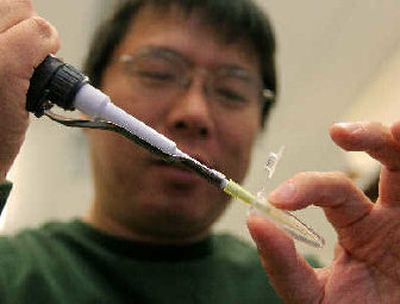‘Dwarf gene’ discovery could be boon for food

PULLMAN – Researchers at Washington State University have discovered the genetic switch that controls the height of plants, raising the possibility of “size-engineered” crops that could produce more food on less water.
The possible applications are many, but one in particular resonates with lead researcher B.W. “Joe” Poovaiah – the potential to make it cheaper and easier to grow food in countries fighting hunger, such as his native India.
“I’ve been living here 40 years, but I can never forget the struggle of the people” in India, Poovaiah said last week in an interview at his lab on campus in Pullman.
Poovaiah led a team of researchers who discovered a way to control the size of plants by altering a single gene. In his office, he has an example of six small plants from the mustard family, all different sizes based on the manipulation of the gene.
The research is the subject of an article in the new issue of the prestigious journal Nature, and it follows decades of inquiry by Poovaiah into the way calcium acts as a messenger in plant reactions.
“It took 30 years – more than 30 years – to get this far,” he said. “It’s like the icing on the cake. It’s the ultimate thing.”
The idea of breeding plants to certain heights isn’t new – though the WSU team’s genetic discovery is. In the 1960s, semi-dwarf wheat hybrids were made available in India as part of the boom in food production known as the green revolution. The plants were several inches shorter than typical plants, but the impact was huge.
“Semi-dwarf wheat has doubled production in India,” Poovaiah said.
But many staple crops such as rice and peas don’t have effective commercial dwarf varieties that are widely available. That could change if scientists can use genetics to control their height. So far, the researchers have found the same gene in every plant they’ve studied.
“We can do something that was impossible before,” said Poovaiah.
Poovaiah has been studying the ways calcium acts as a messenger system in plants for three decades. His research has been funded by a variety of federal agencies, from the Department of Agriculture to the National Aeronautics and Space Administration.
He recently collaborated with scientists in England on a project looking at a gene that has been shown to be a crucial link in the way plants associate with bacteria and fix atmospheric nitrogen.
At the heart of Poovaiah’s research is the complicated system of messages plants use to respond to external stimuli such as light, temperature, bacteria and fungi. The WSU research has focused on calcium’s role in that process.
When plants are acted upon by an outside force, the calcium messenger system is triggered and the calcium spikes in a regular rhythm – a chart of calcium levels looks like an electrocardiogram. This calcium reaction then acts on other parts of the plant to produce responses.
In regard to the height of plants, the calcium and a calcium-binding protein known as calmodulin act on the production of growth hormones called brassinosteroids, which regulate how tall a plant will grow. The WSU research team isolated the gene that controls the production of the protein involved in making the hormone. The researchers found that by manipulating the gene, they could control the height of plants.
Though it is early in the process of researching possible applications, the science could be used to grow more efficient crops in countries where there is widespread hunger, Poovaiah said.
“Dwarf plants use less water and are more resistant to wind and rain damage than normal-size plants,” he said. “They devote a greater proportion of their energy to producing seeds or fruit rather than stems and leaves.”
Poovaiah and a postdoctoral researcher in his lab, Liqun Du, co-authored the Nature paper. He said he’s pleased there’s been international interest in the research – he was corresponding with a newspaper reporter in India last week.
“You start the research not knowing where you’re going. Not knowing where the money’s going to come from. Not knowing who’s going to do it,” he said. “It’s kind of thrilling to see the reaction.”